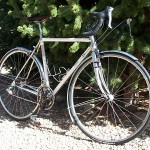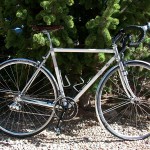The weather report for Saturday was hot, with winds gusting to 45mph, but as I sat on the curb at 3:30am enjoying the calm, I hoped we might get a few hours of respite from the wind before sunrise. However, by 10 minutes ’til 4am the wind had started to pick up. Ah well. I smiled to myself and gave up my last hope that the forecasters had gotten the wind part wrong.
St. Vrain 600k starts in Louisville, Colorado, makes a short jaunt east to Brighton, then back to Lyons, up St. Vrain Canyon to Wind River Pass, down to Estes Park, on to Glen Haven, down Big Thompson Canyon, over to Masonville and Horsetooth Reservoir, heads north to Ft. Collins and Wellington, then over to Gilcrest and back to Louisville to finish the first 400k. The last 200k is a northeastern loop from Louisville going through Evans, Kersey, Hudson, and Brighton.
Prior to this my longest brevet was 300k. I’ve finished longer races; Tejas 500 (miles) and Hill Country 600k. The difference is that an ultracycling race includes race support staff and often each racer has a personal support crew. I had crew for both those events. A brevet, on the other hand, is an unsupported ride. Each rider is responsible for understanding where along the route they can resupply and for carrying what they’ll need. If you have a mechanical or physical problem you figure out how to fix it or hitch a ride back to your car … or phone a friend. But if you think it’s inconvenient to ask someone to drive 10 miles to come pick you up, how about 100 miles!? That would not be unusually far for a rider that has to DNF a brevet.
I haven’t been feeling particularly zippy for the past … oh, month maybe, so my plan was to manage my effort and just get through this last of six brevets in six weeks. I was surprised that the little group of riders started fairly conservatively, but I dropped off the back after 30 min or so, still warming up and not wanting to push it on the rollers. The sun was starting to come up as I left Brighton and the westerly ride was beautiful on the green spring morning. As I rolled into Lyons, the wind was just starting to show signs of the predicted ferocity.
It’s a nice, long, gradual climb to Wind River Pass from Lyons. It’s only 40 miles to Estes Park, and two water bottles will often get me twice that far. I hadn’t planned on the wind increasing my thirst, or calculated the extra time the 4000′ climb would add. All of which meant that 14 miles out of Lyons I was already very low on water. I went off-route at Allenspark hoping for a store, but instead found Crystal Springs! The refreshment was worth the extra half mile. I filled my bottles with ice-cold water and drank another half bottle while I was standing there.
I’d never been to Estes Park before and dropping down into the valley from the south is beautiful! I stopped at the KOA again for more water. Then headed across the valley for the ride down Devil’s Gulch Switchbacks. This entire stretch through Glen Haven, Drake and out Big Thompson Canyon is very scenic. There was A LOT of traffic, but I’m guessing it was a little heavier than usual because another road between Drake and Estes Park was closed.
I was surprised when the route took us by a little reservoir we passed during the Stove Prairie 200k. I had no idea it was nearby. I was starting to feel pretty warm and was looking forward to stopping in Masonville for some nice cold water and ice. Unfortunately all the water in Masonville was warm and there was no ice, but I refilled my bottles and soaked my shirt and headband for some extra cooling and headed on for Horsetooth Dam.
After another stop in Ft. Collins, for yet more water. I have to say the ride got a lot less fun for me after Ft. Collins. I began to question why I was out there and why I’d ever want to do another long ride again! For one thing the wind was stronger out on the plains. And the howling wind, whether from the front, side, or rear, was abrading my nerves. And, while the beauty of the green fields was not lost on me, passing stinky feedlot after stinky feedlot quickly gets tiring (and depressing) to this vegan.
I’d planned to make a quick turnaround after the 400k, but when I got back to my hotel room about 9:30pm, I was too exhausted and sleepy to do anything more than take a shower and go to bed. I thought about DNF’ing, but remembered all the times I’ve wondered why someone would DNF when they still have 10 hours (or, in this case, over 20 hours) to finish, and decided not to make any decision about the last 200k. After I’d been lying in bed (not much sleeping) for about 90 min, I felt refreshed and suddenly motivated to get out there and knock out the rest of the ride.
Back out on the road it was nice. There was little traffic and the wind was calm. I made some routing errors and rode a few extra miles; a combination of not being able to read the tiny print on the cue sheet well and not seeing some road signs in the dark. I’d underdressed and stopped in Miliken to get some coffee and get out of the cold for a few minutes. I put on every stitch of clothing I had with me, unsure if it would be enough; amused at myself because I’m usually so afraid of being cold that I carry enough extra clothing to keep myself and two other people warm. Once I got moving again the light jacket with hood seemed to be just right. By the time I got to Kersey at 4:30am the sky was already starting to lighten. More green fields, more stinky feedlots, a fun descent into Erie, up the rollers to South Boulder Road, across Via Appia and check “done” next to 600k brevet.












































